快速入门 - 使用 Power BI 服Quickstart - Getting around in Power BI service
10/12/2020
本文内容
备注
Power BI 正在转换为新外观,文档中的某些图像可能与服务中显示的图像不匹配。Power BI is moving to a new look, and some images in the documentation may not match what you see in the service. 详细了解新外观,并亲自试用。Learn more about the new look and try it for yourself.
你现已掌握 Power BI 的基础知识,接下来让我们了解 Power BI 服务。Now that you know the basics of Power BI, let's take a look around the Power BI service . 如前一篇文章中所述,团队中的同事可能将所有时间都花在 Power BI Desktop 上,为其他人合并数据和创建报表、仪表板和应用。As mentioned in the previous article, colleagues on your team might spend all of their time in Power BI Desktop , combining data and creating reports, dashboards, and apps for others. 他们是设计者。They're designers . 另一方面,你的时间可能都花在了 Power BI 服务上,用来查看其他人创建的内容并与之交互(使用体验)。You, on the other hand, might spend all of your time in the Power BI service, viewing and interacting with content created by others ( consuming experience). 你是企业用户。You're a business user . 本快速入门适用于企业用户。This quickstart is for business users .
先决条件Prerequisites
如果未注册 Power BI,请免费注册后再进行操作。If you're not signed up for Power BI, sign up for a free trial before you begin.
查看设计者创建的 Power BI 内容(报表、仪表板、应用)需具备以下两种条件之一:Viewing Power BI content (reports, dashboards, apps) created by designers requires one of two conditions:
一个 Power BI Pro 许可证a Power BI Pro license
你的组织要拥有一个 Power BI Premium 订阅,并从高级容量与你共享内容。Your organization to have a Power BI Premium subscription, and the content to be shared with you from Premium capacity.
为介绍本快速入门,我们不要求满足这些条件中的任何一个。For the purposes of this quickstart, we aren't requiring either of these conditions to be met. Microsoft 已直接在 Power BI 服务界面中提供了示例内容。Microsoft has made sample content available to you directly from the Power BI service interface. 我们将使用此示例内容来了解 Power BI 服务。We'll use this sample content to learn our way around the Power BI service.
打开 Power BI 服务Open the Power BI service
若要开始,请打开 Power BI 服务 (app.powerbi.com)。To begin, open the Power BI service (app.powerbi.com).
如果左侧导航窗格已折叠,则请选择导航窗格图标If the left navigation pane is collapsed, select the nav pane icon
 将其展开。to expand it.
将其展开。to expand it.
在左下角,选择“获取数据”。From the lower left corner, select Get data . 我们将获取一些用于 Power BI 服务教程的示例数据。We'll grab some sample data to use for our tour of the Power BI service. 我们提供了各种类型的示例数据供你浏览,这次我们将使用营销和销售数据。There are all types of sample data provided for you to explore, and this time we'll use the data about marketing and sales.

“获取数据”屏幕打开后,选择“示例”。After the Get data screen opens, select Samples .
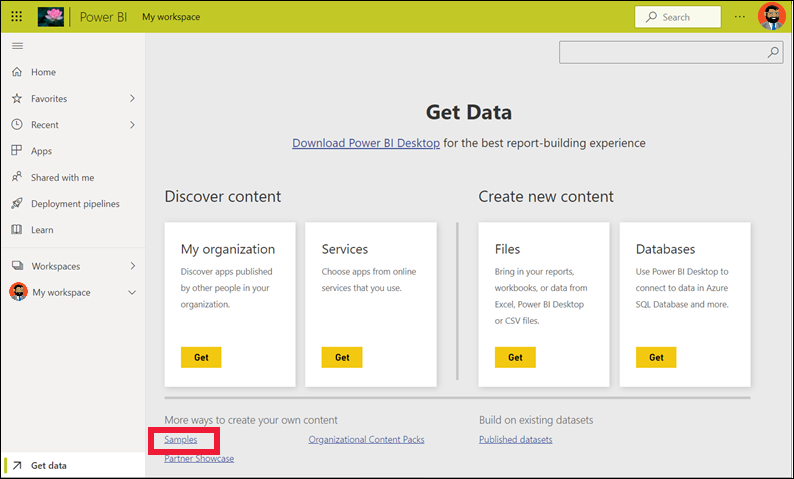
选择“销售和营销” > “连接”。Select Sales and Marketing > Connect .
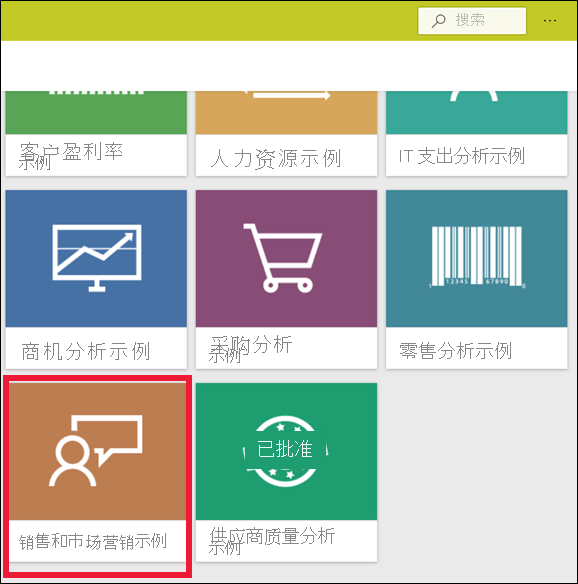
Power BI 服务在“我的工作区”中安装示例。The Power BI service installs the sample in your My workspace . “我的工作区”是用于学习和试验的专用沙盒。My workspace is your private sandbox for learning and experimenting. 只有你自己才能看到“我的工作区”中的内容。Only you can see the content in My workspace . 示例包含一个仪表板、一个报表和一个数据集。The sample includes one dashboard, one report, and one dataset. 通常情况下,企业用户不会收到数据集,但由于此示例是为所有用户设计的,因此它包含一个数据集。Typically, business users won't receive datasets, but this sample is designed for all users and it does include one.
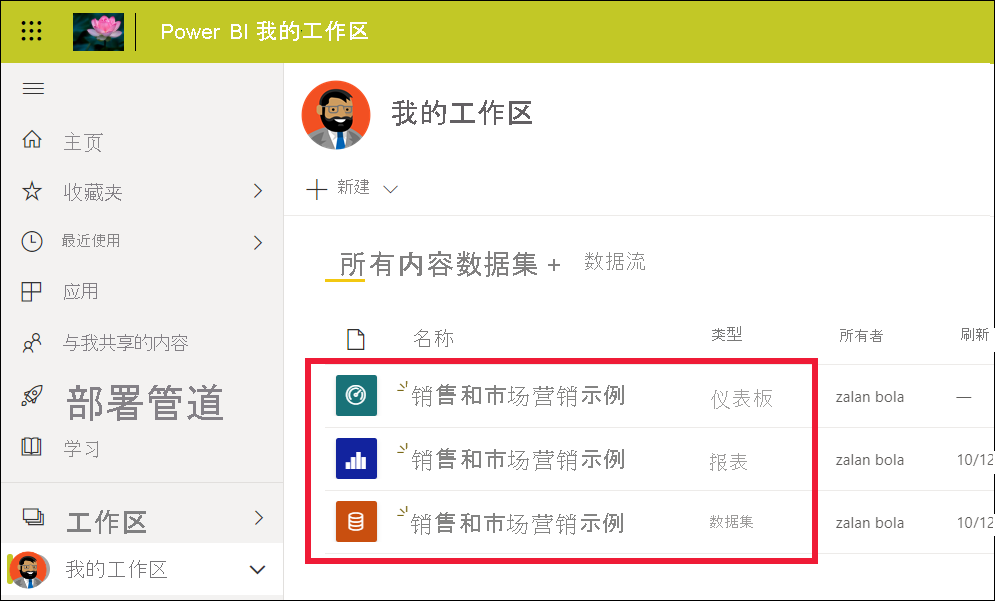
作为企业用户,与你共享的大多数内容不会包括对基础数据集的直接访问。As a business user , most content that is shared with you won't include direct access to the underlying datasets. 由于 Power BI 示例是为所有 Power BI 使用者创建的,因此包含数据集。Because the Power BI samples are created for all Power BI customers, datasets are included.
若要了解有关示例的详细信息,请参阅获取 Power BI 的示例。To learn more about samples, see Get samples for Power BI.
查看内容(仪表板和报表)View content (dashboards and reports)
在工作区的上下文中组织内容。Content is organized within the context of a workspace. 每个企业用户都至少有一个工作区,叫做“我的工作区”。Every business user has at least one workspace, and it's called My workspace . 当设计者同事与你共享内容时,你可能会看到其他工作区。When designer colleagues share content with you, you may end up with additional workspaces. 例如,如果某位设计者向你分配对其中的某个工作区的访问权限,则该工作区将显示在你的 Power BI 站点中。For example, if a designer assigns you access permissions to one of their workspaces, that workspace will show up in your Power BI site.
“我的工作区”存储了你拥有和创建的所有内容。My Workspace stores all the content that you own and create. 可以将其作为你的个人沙盒或自己内容的工作区域。Think of it as your personal sandbox or work area for your own content. 对于很多 Power BI 企业用户来说,“我的工作区”仍然是空的,因为你的工作不涉及新建内容。For many Power BI business user , My workspace remains empty because your job doesn't involve creating new content. 根据定义,企业用户会使用其他人创建的数据,并根据此数据做出业务决策。Business users , by definition, consume data created by others and use that data to make business decisions. If you find that you are creating content, consider reading the Power BI articles for report creators instead.
工作区不仅仅是一个简单的内容列表。A workspace is much more than a simple listing of content. 在本页上,你可详细了解工作区的仪表板和报表。On this page, you can learn a lot about the workspace's dashboards and reports. 请花几分钟时间来确定内容所有者、上次刷新日期、数据敏感度和引导指南(如果有)。Take a few minutes to identify the content owner, last refreshed date, data sensitivity, and endorsements, if any. 选择“更多操作(...)”可显示仪表板和报表的操作列表。Select More actions (...) to display a list of actions for the dashboard and report.
要了解详细信息,请参阅工作区。To learn more, see Workspaces.
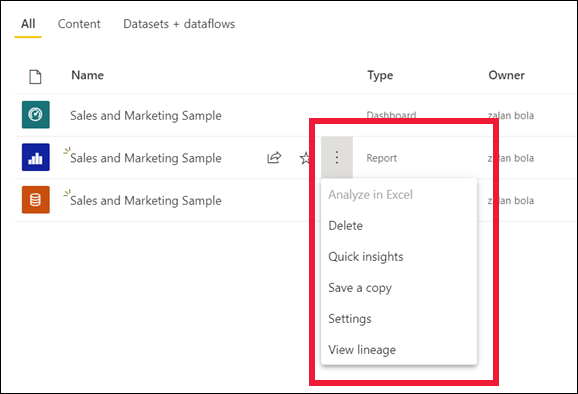
工作区也是指向数据的路径之一。A workspace is also one of the paths into your data. 在工作区中,可从列表中选择仪表板或报表将其打开。From a workspace you can open a dashboard or report by selecting it from the list. 可将鼠标悬停在仪表板或报表上方并选择星形图标将其放入收藏夹。You can favorite a dashboard or report by hovering and selecting the star icon. 如果设计者向你分配共享权限,你也可以从此处共享。If the designer gave you sharing permissions, you can share from here as well.

选择仪表板的名称以将其打开。Select the name of the dashboard to open it. 仪表板可区分 Power BI 服务和 Power BI Desktop。Dashboards are something that differentiates the Power BI service from Power BI Desktop. 了解仪表板Learn about dashboards
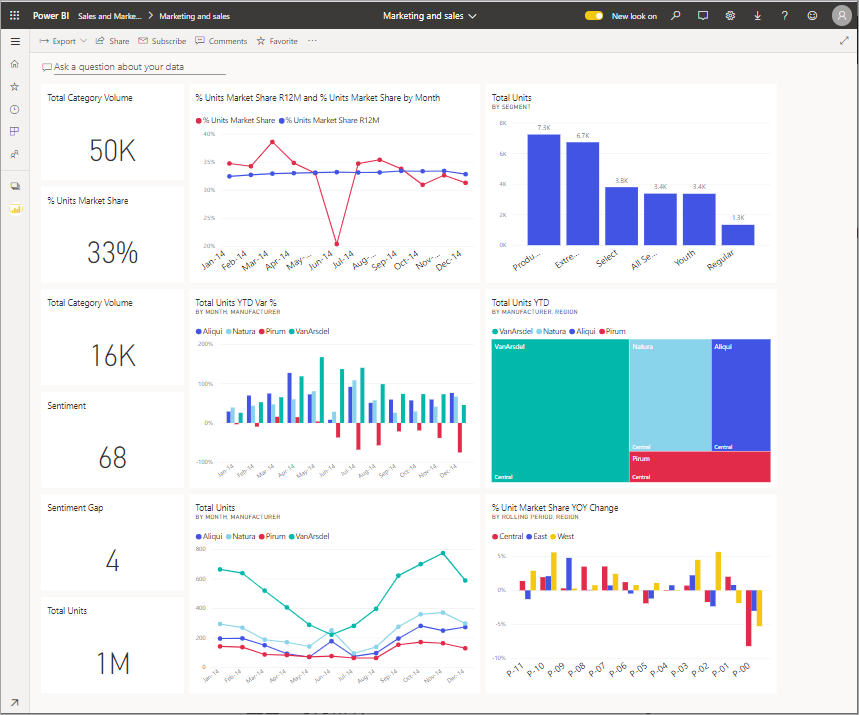
可以在仪表板上执行的操作显示在顶部菜单栏中。The actions you can take on a dashboard are displayed in the top menu bar.

将鼠标悬停在仪表板磁贴上,然后选择“更多选项(...)”,以查看与该磁贴交互可执行的选项。Hover over a dashboard tile and select More options (...) to see the options you have for interacting with that tile.
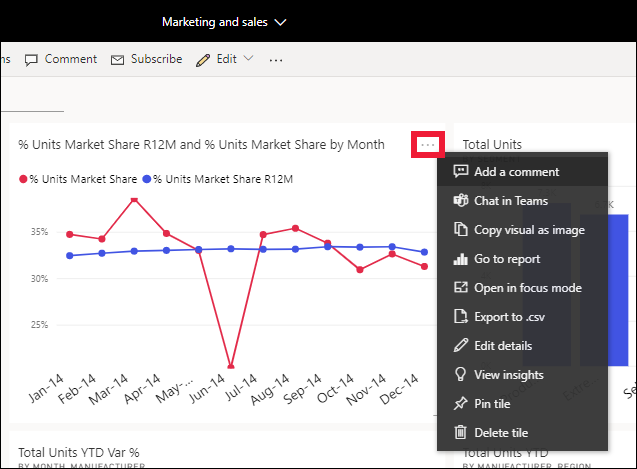
选择仪表板磁贴,打开用于创建该磁贴的报表。Select a dashboard tile to open the report that was used to create that tile. 报表会打开包含该磁贴上的视觉对象的页面。The report opens to the page that contains the visual that is on the tile. 在此处,我选择了包含树状图的仪表板磁贴。Here, I've selected the dashboard tile with the treemap. Power BI 服务将打开“YTD 类别”报表页面。The Power BI service opens the YTD Category report page.
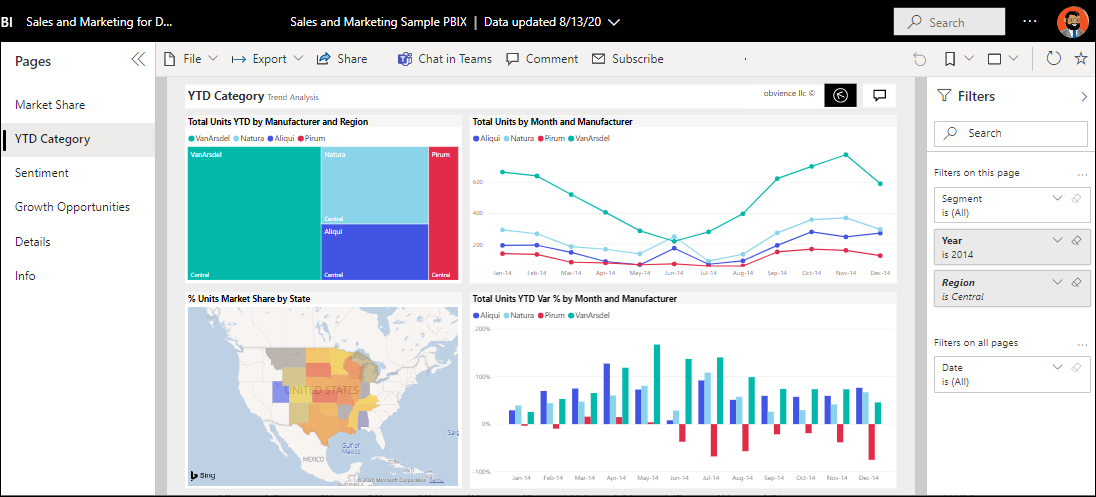
报表包含多个部分。Reports have several sections. 左侧是可单击的报表页列表。On the left is the clickable list of report pages. 顶部是菜单栏,其中包含可对报表执行的操作。Across the top is the menu bar containing actions you can take with the report. 可用选项将取决于报表设计者向你分配的角色和权限。The options available will depend on the role and permission the report designer assigned to you. 右侧是“筛选器”窗格。On the right side is the Filters pane. 中心画布包含报表本身。And the center canvas contains the report itself. 与仪表板类似,此处包含可对整个报表、单个视觉对象以及单个报表页执行的操作。Similar to the dashboard, there are actions that you can take for the entire report, for individual visuals, and also for a single report page.
使用左侧导航窗格Using the left navigation pane
当同事与你共享内容时,导航窗格会更有帮助。The nav pane will become more useful as colleagues share content with you. 在本部分的快速入门中,我们先将销售和营销示例放在一边,并查看拥有大量共享内容的 Power BI 企业用户的仪表板和报表。In this section of the Quickstart, we'll put the Sales and marketing sample aside, and look at a dashboard and report that belong to a Power BI business user who has a lot of shared content.
“主页”是你登录到 Power BI 服务时的默认登录页面。Home is the default landing page when you log in to the Power BI service. “主页”是一种很好的跳转点,也是导航内容的另一种方式。Home is a great jumping off point and alternate way to navigate your content. “主页”上的内容按收藏夹、最近访问、最常访问和精选的方式组织在一起。Content on Home is organized by favorite, recent, frequent, and featured. “主页”还显示最近访问的工作区和应用。Home also displays your most recent workspaces and apps. 只需选择一个项目即可将其打开。Just select an item to open it.
“主页”将搜索和排序工具、导航窗格和画布汇聚在一起,有卡片供你选择来打开仪表板、报表和应用 。Home brings together the searching and sorting tools, the nav pane, and a canvas with cards that you can select to open your dashboards, reports, and apps. 最开始,“主页”画布上可能没有很多卡片,但随着你开始与同事一起使用 Power BI,这种情况将会发生改变。At first, you might not have many cards on your Home canvas, but that will change as you start to use Power BI with your colleagues. “主页”画布也会更新推荐的内容和学习资源。Your Home canvas also updates with recommended content and learning resources.
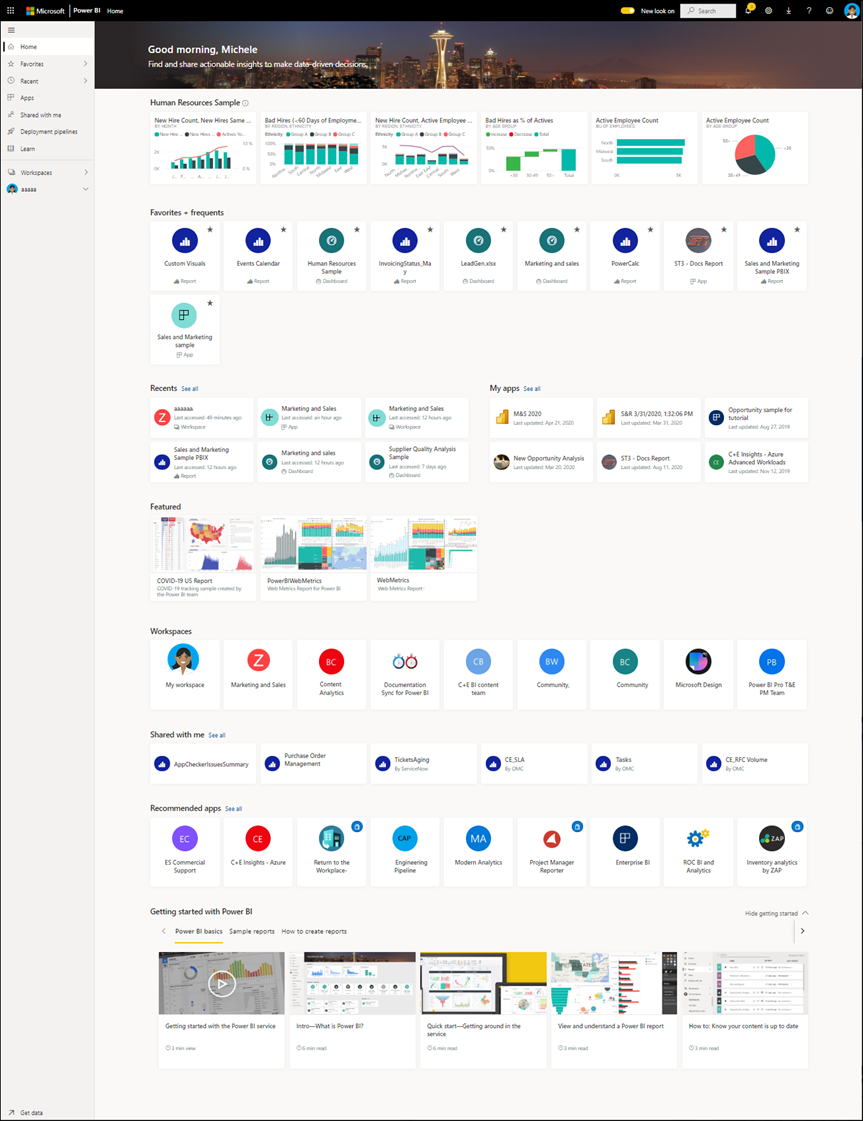
要了解详细信息,请参阅 Power BI 主页To learn more, see Power BI Home
“收藏夹”和“最近访问”都有箭头。Favorites and Recent both have arrows. 选择一个箭头,快速查看前五个收藏夹或五个最近访问的内容。Select an arrow to quickly see the top five favorites or five most recently visited content. 在浮出控件中选择内容将其打开。From the flyout, select content to open it.
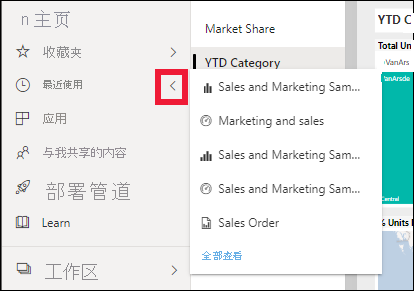
若要查看收藏夹或最近访问的完整列表,请选择单词或图标。To see your full list of favorites or recents, select the word or icon. 这些内容列表提供有关报表、应用和仪表板的其他详细信息。These content lists provide additional details about the reports, apps, and dashboards.
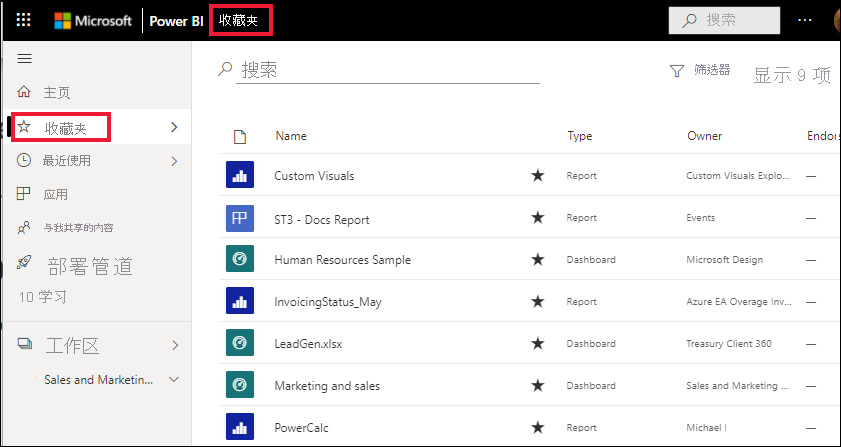
选择“应用”可显示已与你共享或你已安装的所有应用。Select Apps to display all apps that have been shared with you or that you have installed. 选择“与我共享”可显示已与你共享的仪表板和报表。And select Shared with me to see dashboards and reports that have been shared with you. 由于你刚开始使用 Power BI 服务,因此这些内容区域是空的。Since you're just starting out with the Power BI service, these content areas will be empty.
对内容进行搜索和排序Search and sort content
刚使用 Power BI 服务时,你只有少量的内容。When you're new to the Power BI service, you'll have only a few pieces of content. 但随着同事开始与你共享内容以及你开始下载应用,你最终可能会有大量的内容。But as colleagues begin sharing content with you and you begin downloading apps, you may end up with long lists of content. 那时你会发现搜索和排序非常有用。That's when you'll find searching and sorting extremely helpful.
几乎可以从 Power BI 服务的每个部分进行搜索。Search is available from almost every part of the Power BI service. 只需查找搜索框或搜索放大镜图标即可。Just look for the search box or search magnifying glass icon.

在“搜索”字段中,键入仪表板、报表、工作簿、应用或所有者的完整或部分名称。In the Search field, type all or part of the name of a dashboard, report, workbook, app, or owner. Power BI 会搜索所有内容。Power BI searches all of your content.

也有多种方式可对内容进行排序。There are also many ways to sort content. 请将鼠标悬停在列标题上,查找表示可对列进行排序的箭头。Hover over column headers and look for arrows indicating that the column can be sorted. 不是所有列都可以进行排序。Not all columns can be sorted.
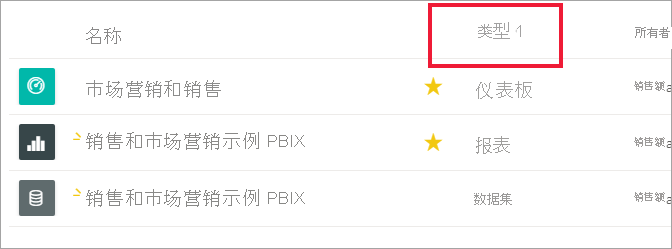
或者,查找内容列表右上角附近的搜索筛选器。Or, look for the Search Filters near the upper right corner of your content lists. 通过从内容类型、所有者或任何其他可用字段中进行选择来快速查找内容。Find content quickly by selecting from the type of content, owner, or any other available field.
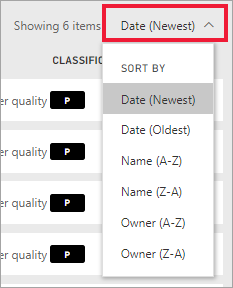
查找所有者Find the owner
在本快速入门结尾,我们将提供一个有用的提示。And we'll end this quickstart with a helpful tip. 如果对仪表板、报表或应用有任何疑问,可以查找所有者。If you have questions about a dashboard, report, or app -- you can look up the owner. 打开内容后,选择标题下拉列表可显示所有者。With the content open, select the title dropdown to display the owner. 所有者可能是个人或团体。The owner may be a person or a group.

清理资源Clean up resources
完成本快速入门后,你可根据需要删除示例仪表板、报表和数据集。After you finish this quickstart, you can delete the sample dashboard, report, and dataset, if you wish.
打开 Power BI 服务 (app.powerbi.com) 并登录。Open the Power BI service (app.powerbi.com) and sign in.
打开 Power BI 主页,向下滚动并选择“我的工作区”。Open Power BI Home, scroll down and select My workspace .
将鼠标悬停在仪表板、报表或数据集上,然后选择“更多选项(...)” > “删除”。Hover over the dashboard, report, or dataset and select More options (...) > Delete . 重复此操作,直到三项内容均被删除。Repeat until all three are removed.
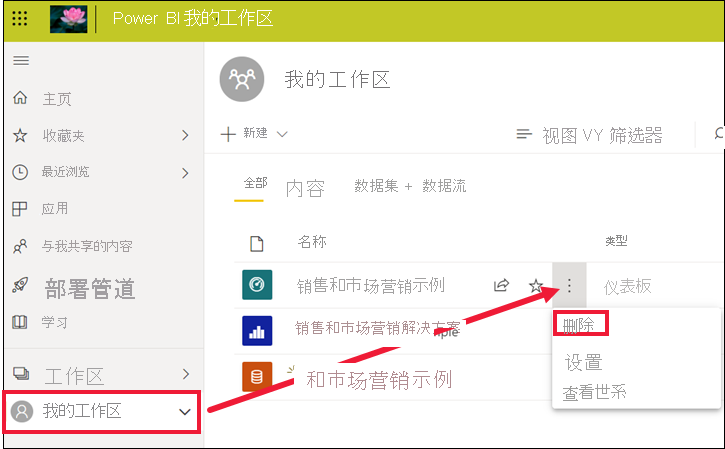
后续步骤Next steps

着色)

作业 题库)

作业 题库)


作业 题库)










